In the desolate snowclad region of the Shogawa River Valley, lies a village of rustic straw-roofed farmhouses. In the freezing chill of winter, the warm lights of these picturesque farmhouses is a welcome sight to any traveller.
Declared a UNESCO world heritage site in 1995, this valley spanning the Shirakawago and Gokayama regions is famous for their traditional Gasshō-Zukuri farmhouses, some of which are more than 250 years old.
Gasshō-Zukuri (合掌造) means "constructed like hands in prayer", as the farmhouses' steep thatched roofs resemble the hands of Buddhist monks pressed together in prayer.
The architectural style developed over many generations and is designed to withstand the large amounts of heavy snow that falls in the region during winter. The roofs, made without nails, provided a large attic space used for cultivating silkworms.
A similar-styled 18th-century Stöckli house in Bern, Switzerland in an area with heavy snowfall compared with the Takenaka-ke House in Suganuma Village...
Coming to a rustic and remote place, you'd expect the thatching to be done the traditional and amateur way. But no, here in Shirakawago, attention is paid to safety and professional to maintain the beauty and safety of the heritage site...
The Shogawa River Valley site spans the Gifu and Toyama prefectures and consists of 3 main villages: Gifu's Ogimachi (Shirakawago's largest village) and Gokayama's Suganuma and Ainokura villages in Toyama.
Ogimachi
Ogimachi is the largest village and main attraction of Shirakawago. It is also the transport hub of the Shirakawago region, where the bus lines from Takayama, Nagoya, Kanazawa and Takaoka meet.
Gasshō-Zukuri Minkaen is an open air museum across the river exhibiting farmhouses and other structures relocated to Ogimachi in order to save them from destruction...






The Shiroyama Viewpoint is north of the village centre and offers nice views of Ogimachi and its farmhouses...
Myozenji Temple, which is unique for its thatched roof rather than the typical tiled roof seen on most temples, is connected to the Myozenjike farmhouse next door where the priest of the temple lives...


Suganuma
Gokayama is a place of precipitous mountains and deep valleys located in the southeastern part of Toyama. It is believed that Gokayama, which means five valleys, was so named because there was a village among five valleys: Akao-Dani, KamiNashi-Dani, ShimoNashi-Dani, Otani, and Toga-Dani along the Shogawa River.
Suganuma, one of the main attractions of Gokayama, is made up of two areas, Suganuma Village and the Gokayama Gassho No Sato. Pleasant and easy to explore on foot, the two areas are connected to each other by a tunnel, which also connects to the parking lot on the hill overlooking the village via an elevator.
Like its sister villages, you can see the traditional Gasshō-Zukuri farmhouses in Suganuma Village. A few of them here have become restaurants, minshuku, and museums showing the daily life and the washi paper and gunpowder industries that sustained the region.
Making saltpeter, an ingredient in gunpowder, was an important industry for the region during the Edo Period. This museum has exhibits on the procedures, tools and history of the industry in Gokayama...
The Folk Museum displays tools and household items used in daily life,
e.g. for farming, raising silkworms and making washi paper...
On the other end of the tunnel, the Gokayama Gassho No Sato has a number of traditional farmhouses which have been relocated here in order to save them from destruction. Uninhabited, they are instead used by school groups who can stay overnight in the houses and experience activities from traditional Gokayama life.
Ainokura
Set far back in the valley, Ainokura is the most remote village in the Gokayama region. It is also the largest of the villages with nearly 20 Gasshō-Zukuri farmhouses. Many of them remain private residences, although a few have been converted into restaurants, museums, and minshuku. As it is less developed and harder to get to than Ogimachi, Ainokura is quieter and sees less tourist traffic, and offers similar attractions.
Ainokura Viewpoint
The viewpoint above Ainokura is a 5-10 minute walk up the mountain. The trail begins behind the information building at the parking lot, goes through a few fields and connects with a small road. If you continue up the hill on the road you will be rewarded with nice aerial views of the village.
Gokayama Washi
The Gokayama region has been well known for its washi paper since the art was brought here by Taira Clan refugees from Kyoto. At this store/factory you can watch how washi paper is made, or try your hand at making some yourself (advance notice required).
Murakami-Ke House
This farmhouse turned museum is known for its owner who gives tours of the house which end with performances of local folk songs accompanied by regional instruments.
Uta No Yakata
Uta No Yakata is a museum dedicated to the unique music of the Gokayama region. Videos of the traditional music and dance are show here. You can also learn to play some of the instruments such as the sasara.
Location Icons
A curtain with the iconic houses...
Even the manhole has these icons...
Throughout The Seasons
With the mountain mist...
In spring...
Sources
Accommodation
- Japanese Guest House
http://www.japaneseguesthouses.com/ryokan-search-results/?area=Shirakawa-go
Credits
- 500pxhttps://500px.com/photo/65043651/street-in-shirakawa-go-by-miyamoto-y
- Arts And Crafts Homes http://artsandcraftshomes.com/the-swiss-chalet/
- Cool Japan Guide
http://satoh490625.blog50.fc2.com/blog-entry-652.html
- iStock Photo
http://www.istockphoto.com/stock-photos
- Japan Guide
http://www.japan-guide.com/e/e5950.html
http://www.japan-guide.com/e/e5951.html
http://www.japan-guide.com/e/e5954.html
http://www.japan-guide.com/e/e5955.html
- Japan Visitorhttp://www.japanvisitor.com/japan-city-guides/shirakawa-go
- JapTAL 2012http://lang.cs.tut.ac.jp/japtal2012/social_event/
- JNTO http://www.jnto.go.jp/eng/location/regional/toyama/gokayama.html
- Minube
http://www.minube.net/place/gassh_zukuri-minka_en--a91651
- National Geographic
http://ngm.nationalgeographic.com/ngm/photo-contest/2012/entries/196929/view/
- Quirky Japan Blog
https://qjphotos.wordpress.com/2008/10/27/shirakawa-go/
- Staying Global
http://stayingglobal.blogspot.sg/2014_02_01_archive.html
- Trek Earth
http://www.trekearth.com/gallery/Asia/Japan/Chubu/Toyama/Gokayama/photo1274168.htm
- When On Earth
http://whenonearth.net/13-of-the-most-charming-small-towns-in-the-world/
- Yokoso Japan
http://www.yokoso-japan.jp/en/86330.html - Zavadsky
http://www.zavadsky.net/david/travel/2006-world/jp/?10459






















.jpg)
























